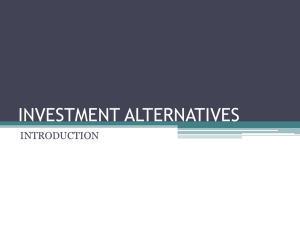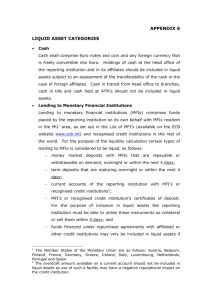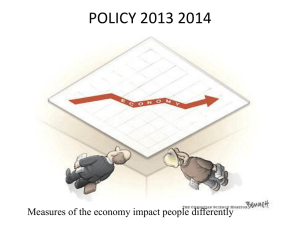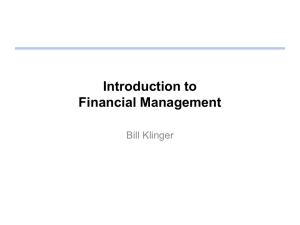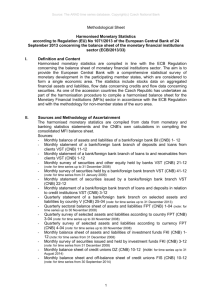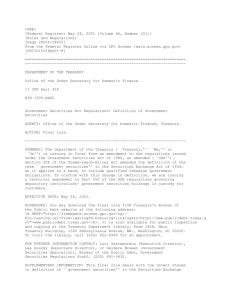Chapter Two POF - 14th Ed
advertisement
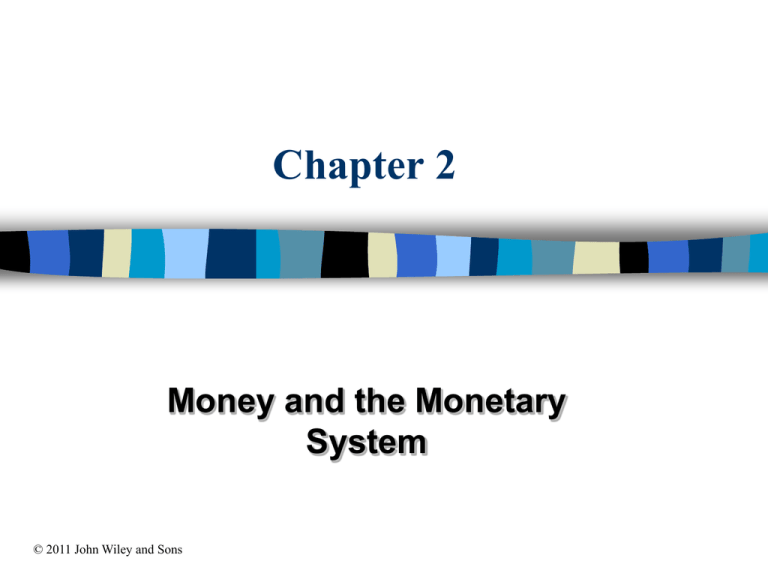
Chapter 2 Money and the Monetary System © 2011 John Wiley and Sons Chapter Outcomes Describe the three ways in which money is transferred from savers to businesses Identify the major components of the monetary system Describe the functions of money Give a brief review of the development of money in the U.S. 2 Chapter Outcomes (Continued) Describe major types of money market securities Briefly explain the M1, M2, and M3 definitions of the money supply Explain possible relationships between money supply and economic activity Comment on developments in the international monetary system 3 Process of Moving Savings into Investments Surplus Economic Unit: generates more money than it spends resulting in excess money Deficit Economic Unit: generates less money than it spends resulting in a need for additional money 4 Savings-Investment Process Direct Transfers: Money Savers Business Firm Securities Indirect Transfers: Savers Money Securities Savers Money Institution Securities Investment Banking Firm Financial Institution Money Securities Money Firm’s Securities Business Firm Business Firm 5 Participants in the U.S. Monetary System CENTRAL BANK: Defines and Regulates Money Supply Facilitates the Transferring of Money BANKING SYSTEM: Creates Money Transfers Money Provides Financial Intermediation Processes/Clears Checks 6 The U.S. Monetary System Central Bank Federal Reserve System Board of Governors Federal Reserve Banks Facilitates transfer of money through check processing/clearing Defines and regulates money supply Banking System: 1. Creates money 2. Transfers money 3. Provides financial intermediation 4. Processes/clears checks First Bank Other Banks Last Bank 7 U.S. Central Bank Federal Reserve System [often referred to as the “Fed”] Board of Governors Federal Reserve Banks 8 Central Bank Activities Defines and regulates money supply Facilitates the transferring of money through check processing and clearing 9 Importance and Functions of Money Real Assets: direct ownership of land, buildings or homes, equipment, inventories, durable goods, and precious metals Financial Assets: money, debt securities & contracts, and equity securities backed by real assets & earning power of issuers 10 Some Basic Definitions MONEY: anything generally accepted as payment for goods, services, & debts BARTER: exchange of goods or services without using money LIQUIDITY: ease and low cost of exchanging an asset for money 11 Functions of Money MEDIUM OF EXCHANGE: the basic function of money STORE OF VALUE: money can be held for some period of time, without losing its value, before it is spent STANDARD OF VALUE: exists when prices and debts are stated in terms of the monetary unit 12 Development of Money in the U.S. Historical Types of U.S. Coins: FULL-BODIED MONEY: coins that contain the same value in metal as their face value TOKEN COINS: coins containing metal of less value than their stated value 13 Development of Money in the U.S. Historical Types of Paper Currency: REPRESENTATIVE FULL-BODIED MONEY: paper money fully backed by a precious metal FIAT MONEY: legal tender proclaimed to be money by law--not backed by precious metal 14 Deposit Money in the U.S. CREDIT MONEY: money worth more than what it is made of--backed by the creditworthiness of issuer DEPOSIT MONEY: special type of credit money backed by the depository institution that issued the deposit 15 Alternatives to “Paper Checks” AUTOMATIC TRANSFER SERVICE (ATS) ACCOUNTS: Provide for direct deposits to, and payments from, checkable deposit accounts DEBIT CARDS: Provide for immediate direct transfer of deposit amounts & can be used to make cash withdrawals from ATMs 16 Money Market Securities Money Markets: markets where debt securities with maturities of one year or less are originated (primary markets) or traded (secondary markets) Money Market Securities: debt securities with maturities of one year or less 17 Money Market Securities Treasury Bill: short-term debt obligation issued by the U.S. federal government Negotiable Certificate of Deposit: short-term debt instrument issued by depository institutions that can be traded in the secondary money markets 18 Money Market Securities Commercial Paper: short-term unsecured note issued by a high credit-quality corporation Banker’s Acceptance: promise of future payment issued by an importing firm and guaranteed by a bank 19 Money Market Securities Repurchase Agreement: short-term debt security where the seller agrees to repurchase the security at a specified price and date Federal Funds: very short-term loans between depository institutions with excess funds and those needing funds 20 Measures of the U.S. Money Supply M1 Money Supply M2 Money Supply M3 Money Supply 21 Components of the M1 Definition of the Money Supply Currency Traveler’s Checks Demand Deposits at Banks Other Checkable Deposits at Depository Institutions 22 Components of the M2 Definition of the Money Supply M1 Money Supply plus: Savings Accounts Small-Denomination Time Deposits Money Market Deposit Accounts (MMDAs) Retail Money Market Mutual Funds (MMMFs) 23 Components of the M3 Definition of the Money Supply M2 Money Supply plus: Large-Denomination Time Deposits Institutional Money Market Mutual Funds Repurchase Agreements (Overnight and Term) Eurodollars (Overnight and Term) Held by U.S. Residents 24 Money Supply and Economic Activity MONETARISTS’ VIEW: amount of money in circulation determines the level of economic activity KEYNESIANS’ VIEW: change in money supply first causes a change in interest rates which then, in turn, alters the demand for goods and services 25 Monetarists’ View BASIC EQUATION: MS x VM = GDP GROSS DOMESTIC PRODUCT (GDP): Measures the output of goods and services in an economy MONEY SUPPLY (MS): Usually defined in terms of M1 or M2 VELOCITY OF MONEY (VM): The rate of circulation of the money supply 26 Another View of GDP BASIC EQUATION: RO x PL = GDP GROSS DOMESTIC PRODUCT (GDP): Measures the output of goods and services in an economy REAL OUTPUT (RO): Units of goods and services PRICE LEVEL (PL): Average price of goods and services 27 Two Views of GDP Combined TWO BASIC EQUATIONS: MS x VM = GDP RO x PL = GDP THE EQUATIONS COMBINED: MS x VM = RO x PL NOMINAL GDP INCREASES WITH: >An increase in money supply and/or velocity of money >An increase in real output and/or price level 28 International Monetary System Historically: Tied to the gold standard Bretton Woods System (1944): Agreement to use fixed or pegged exchange rates tied to the U.S. dollar or gold Early 1970s: Development of a flexible or floating exchange rate system 29 International Monetary System Terms CURRENCY EXCHANGE RATE: Value of one currency relative to another EURO: A single currency that replaced the individual currencies of initially twelve member countries of the European Union 30 Web Links www.frbsf.org www.federalreserve.gov www.stlouisfed.org www.treas.gov 31

